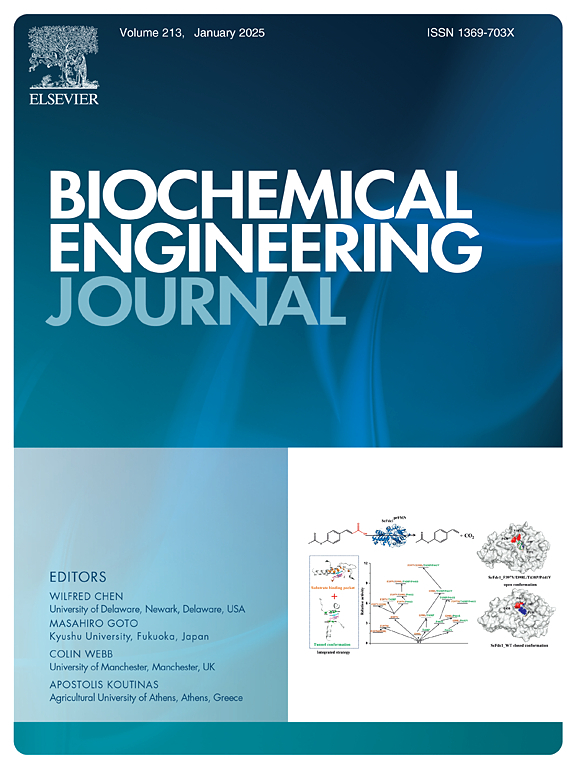Cell Dome-based transfection array for non-adherent suspension cells
IF 3.7
3区 生物学
Q2 BIOTECHNOLOGY & APPLIED MICROBIOLOGY
引用次数: 0
Abstract
Cell-based microarrays are valuable tools for analyzing cellular functions. However, a significant limitation of conventional microarrays is their inapplicability to non-adherent cells. In this study, we investigated the potential of the ‘Cell Dome’ (diameter: 1 mm, height: approximately 300 µm) with a 90 µm-thick hydrogel shell as a gene transfection array for non-adherent cells in suspension. The human lymphoma cell line (K562 cells), used as a model for non-adherent cells, was transfected more efficiently by Lipofectamine/pDNA complexes on a composite hydrogel made of polyvinyl alcohol derivative (PVA-Ph) and chitosan derivative (chitosan-Ph) than hydrogels composed of an alginate derivative or PVA-Ph alone. Moreover, no significant adverse effects on the viability and proliferation of the enclosed cells were observed for Cell Dome with a PVA-Ph/chitosan-Ph composite hydrogel shell. Lipofectamine/pDNA complexes released from the bottom of Cell Domes could transfect the enclosed cells without leaking or contaminating adjacent Cell Domes. These results demonstrate the potential of Cell Domes with an appropriate hydrogel shell as transfection arrays for non-adherent cells in suspension, thereby expanding the range of applications of cell-based array technologies. This novel Cell-Dome transfection array would be a valuable tool for analyzing the cellular function of non-adherent cells in suspension and showcases the potential for providing important biomedical insights for future research and developments.
基于细胞穹顶的非粘附悬浮细胞转染阵列
基于细胞的芯片是分析细胞功能的重要工具。然而,传统微阵列的一个重要局限是不适用于非粘附细胞。在这项研究中,我们研究了带有 90 微米厚水凝胶外壳的 "细胞穹顶"(直径:1 毫米,高度:约 300 微米)作为基因转染阵列用于悬浮非粘附细胞的潜力。以人类淋巴瘤细胞株(K562 细胞)为非粘附细胞模型,在由聚乙烯醇衍生物(PVA-Ph)和壳聚糖衍生物(壳聚糖-Ph)组成的复合水凝胶上,脂质体转染胺/pDNA 复合物的转染效率要高于单独由海藻酸衍生物或 PVA-Ph 组成的水凝胶。此外,带有 PVA-Ph/ 壳聚糖-Ph 复合水凝胶外壳的 Cell Dome 对被包裹细胞的活力和增殖没有明显的不良影响。从细胞穹顶底部释放的脂质体/pDNA 复合物可以转染被封闭的细胞,而不会泄漏或污染相邻的细胞穹顶。这些结果表明,带有适当水凝胶外壳的细胞穹顶具有作为悬浮非粘附细胞转染阵列的潜力,从而扩大了基于细胞的阵列技术的应用范围。这种新型细胞穹顶转染阵列将成为分析悬浮液中非粘附细胞功能的重要工具,并有可能为未来的研究和开发提供重要的生物医学见解。
本文章由计算机程序翻译,如有差异,请以英文原文为准。
求助全文
约1分钟内获得全文
求助全文
来源期刊

Biochemical Engineering Journal
工程技术-工程:化工
CiteScore
7.10
自引率
5.10%
发文量
380
审稿时长
34 days
期刊介绍:
The Biochemical Engineering Journal aims to promote progress in the crucial chemical engineering aspects of the development of biological processes associated with everything from raw materials preparation to product recovery relevant to industries as diverse as medical/healthcare, industrial biotechnology, and environmental biotechnology.
The Journal welcomes full length original research papers, short communications, and review papers* in the following research fields:
Biocatalysis (enzyme or microbial) and biotransformations, including immobilized biocatalyst preparation and kinetics
Biosensors and Biodevices including biofabrication and novel fuel cell development
Bioseparations including scale-up and protein refolding/renaturation
Environmental Bioengineering including bioconversion, bioremediation, and microbial fuel cells
Bioreactor Systems including characterization, optimization and scale-up
Bioresources and Biorefinery Engineering including biomass conversion, biofuels, bioenergy, and optimization
Industrial Biotechnology including specialty chemicals, platform chemicals and neutraceuticals
Biomaterials and Tissue Engineering including bioartificial organs, cell encapsulation, and controlled release
Cell Culture Engineering (plant, animal or insect cells) including viral vectors, monoclonal antibodies, recombinant proteins, vaccines, and secondary metabolites
Cell Therapies and Stem Cells including pluripotent, mesenchymal and hematopoietic stem cells; immunotherapies; tissue-specific differentiation; and cryopreservation
Metabolic Engineering, Systems and Synthetic Biology including OMICS, bioinformatics, in silico biology, and metabolic flux analysis
Protein Engineering including enzyme engineering and directed evolution.
 求助内容:
求助内容: 应助结果提醒方式:
应助结果提醒方式:


